 W
WThe bay whiting is a species of coastal marine fish of the smelt-whiting family, Sillaginidae. The bay whiting's range extends throughout the west Indian Ocean, including northern Australia, Thailand, India and Taiwan, where it inhabits protected waters. It is benthic in nature, preying on shrimps, polychaetes and molluscs, however little else is known of its biology. Bay whiting are an important part of some inshore fisheries around Australia and Asia, where subsistence and commercial fishermen regularly take the species.
 W
WBetta tussyae is a species of gourami endemic to Malaysia where it is only known from Pahang. It is an inhabitant of peat swamps. This species grows to a length of 3.7 centimetres (1.5 in) SL. The specific name honours Tussy Nagy, the wife of the Austrian aquarist Peter Nagy, in 1979 this couple were the first fish collectors to import this species into Europe.
 W
WThe broadmouth catshark is a rare catshark of the family Scyliorhinidae, the holotype and only specimen of which was taken from off Zhujiang in the South China Sea, at a depth of 913 m. Its length is around 38 cm. The broadmouth catshark's reproduction is oviparous. Considering the species is not well known, the threats are not known either but may be deepwater fisheries.
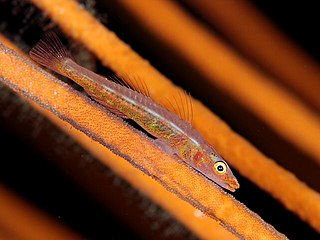 W
WBryaninops amplus, known commonly as the large whip goby or white-line seawhip goby, is a species of marine fish in the family Gobiidae.
 W
WBryaninops natans, known commonly as the redeye goby, is a species of marine fish in the family Gobiidae.
 W
WThe Conasauga logperch is a species of freshwater ray-finned fish, a darter from the subfamily Etheostomatinae, part of the family Percidae, which also contains the perches, ruffes and pikeperches. It is endemic to the United States. It is one of 184 species of darters in North America. It has been listed as endangered throughout its range with critical habitat since August 5, 1985.
 W
WThe crimson cleaner fish, or butcher's dick in Australia, is a species of wrasse native to the southwestern Pacific Ocean around Australia and New Zealand. This species inhabits patches of sand on reefs at depths of from 6 to 100 metres. It is a cleaner fish. Males of this species can reach a length of 11.7 centimetres (4.6 in) SL while females only reach 8.6 centimetres (3.4 in).
 W
WThe cylindrical lanternshark or Carter Gilbert's lanternshark is a shark of the family Etmopteridae found along the Caribbean coast of Colombia in South America, at depths of between 285 and 355 m. Its maximum length is 21 cm.
 W
WDawkinsia srilankensis, the blotched filamented barb, is a species of ray-finned fish in the genus Dawkinsia. This species is endemic to the Kalu River in Sri Lanka and it is in imminent danger of going extinct due to tailings from upstream mines and potentially also capture for the aquarium trade. It was bred recently in the Dehiwala Zoological Gardens.
 W
WThe dwarf lanternshark is a little-known species of dogfish shark in the family Etmopteridae and is the smallest shark in the world, reaching a maximum known length of 20 cm (7.9 in). It is known to be present only on the upper continental slopes off Colombia and Venezuela, at a depth of 283–439 m (928–1,440 ft). This species can be identified by its small size at maturity, long flattened head, and pattern of black ventral markings and a mid-dorsal line. Like other members of its genus, it is capable of producing light from a distinctive array of photophores. Reproduction is aplacental viviparous, with females gestating two or three young at a time. The dwarf lanternshark is not significant to commercial fisheries, but could be threatened by mortality from bycatch; the degree of impact from human activities on its population is unknown.
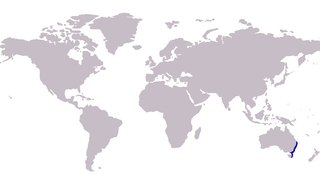 W
WThe eastern school whiting, Sillago flindersi, is a species of benthic marine fish of the smelt-whiting family Sillaginidae. The eastern school whiting is endemic to Australia, distributed along the east coast from southern Queensland down to Tasmania and South Australia, where it inhabits sandy substrates from shallow tidal flats to depths of 180 m on the continental shelf. Eastern school whiting prey on various crustaceans and polychaete worms, with the diet varying seasonally and throughout the range of the species. Eastern school whiting reproduce in the deeper waters twice a year, releasing up to 110,000 eggs during a season.
 W
WFedorov's catshark is a catshark of the family Scyliorhinidae. This shark has oviparous reproduction. This is a very poorly known species, with less than 30 specimens reported in the scientific literature. Almost nothing is known of its biology. This species may be endemic to northern Japanese waters, where it is taken in water around 1,200 m deep. However, accurate identification of Apristurus species is particularly difficult, and further research is required to determine its geographical and bathymetrical distribution.
 W
WThe flavescent peacock, also known as Grant's peacock, is a species of haplochromine cichlid. Its common name refers to its "flavescent" (yellowish) colour.
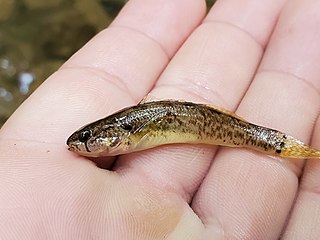 W
WThe fringed darter is a species of freshwater ray-finned fish, a darter from the subfamily Etheostomatinae, part of the family Percidae, which also contains the perches, ruffes and pikeperches. It is endemic to the eastern United States, where it occurs in the drainage of the Cumberland River, the Duck River system, the Shoal Creek system, and the tributaries of the Reelfoot Lakes of Kentucky, Tennessee, and Alabama. It is an inhabitant of small streams and rocky pool and nearby riffles where they prey on insect larvae and nymphs, as well as small crustaceans. This species can reach a length of 10 cm (3.9 in).
 W
WHaplochromis nyererei is a species of cichlid endemic to Lake Victoria in Africa. This species can reach a length of 7.7 centimetres (3.0 in) SL. The specific name honours Julius Nyerere (1922-1999) who was President of Tanzania from 1961–1985.
 W
WThe humpback cat shark is a cat shark of the family Scyliorhinidae in the order Carcharhiniformes, found in the northwest Pacific Ocean off Zhujiang, South China Sea, from the surface to 915 m. Its length is 39–41 cm. The largest specimen examined by Nakaya and Sato was 54.2 cm TL. The humpback catshark is a little-known oviparous deepwater catshark.
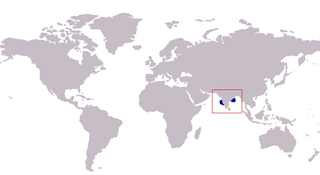 W
WThe Indian whiting is a poorly known species of coastal marine fish of the smelt-whiting family Sillaginidae. The species was named in 1985, having previously being misidentified as another species of Sillago, S. parvisquamis. The Indian whiting inhabits the east and west coasts of the Indian subcontinent, apparently not extending to the southern tip of India. Like all sillaginids, it is benthic in nature, living in depths to 30 m where it is caught by fishermen alongside other species of Sillago.
 W
WThe Japanese roughshark is a rare species of shark in the family Oxynotidae, known only from a handful of specimens recovered from Suruga Bay and the Enshunada Sea off Japan. It is a benthic species that occurs at a depth of 150–350 m (490–1,150 ft). This shark is caught as bycatch by bottom trawlers throughout its entire limited range, and may be threatened given the declines in other bottom deep sea species in Suruga Bay.
 W
WMcMillan's catshark is a catshark of the family Scyliorhinidae, in the order Carcharhiniformes. McMillan's cat shark is a small, rare and little-known deepwater shark. It is endemic to New Zealand. This species is found in the deep waters of the lower continental slope around New Zealand, on the West Norfolk Ridge and off North Cape. This species can be found at depths of 985-1350m. It can grow up to a length of 45 cm.
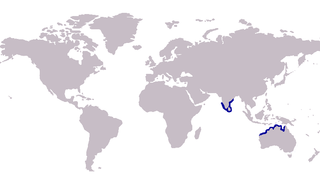 W
WThe mud whiting, Sillago lutea, is a species of coastal marine fish in the smelt-whiting family Sillaginidae. The mud whiting was first described in 1985 and is currently known from the north west coast of Australia and the Indian coast.
 W
WThe nkhomo-benga peacock, also known as the new yellow regal peacock, is a species of haplochromine cichlid which is endemic to Lake Malawi. This species is threatened by capture for the aquarium trade.
 W
WOdontobutis platycephala is a species of freshwater sleeper endemic to South Korea.
 W
WParamormyrops hopkinsi (Taverne and Thys van den Audenaerde, 1985) is a species of freshwater electric fish. It was discovered in the Ivindo River in Gabon, in west-Central Africa by Dr. Carl D. Hopkins of Cornell University. It is distributed throughout the Ivindo River basin of Gabon and the Ntem River basin of Cameroon. Described originally as a Brienomyrus in 1985 it was transferred to Paramormyrops in 2007. The electric discharge has two phases: a head-positive phase followed by a head-negative phase. The mean duration of the EOD is 2.8 ms for females, 2.96 for males. The Fourier transform of the EOD peaks at 536 Hz for females, 468 for males. Both male and female EODs have a head-negative voltage bump about 5 to 6 ms after the main head positive phase (arrows).
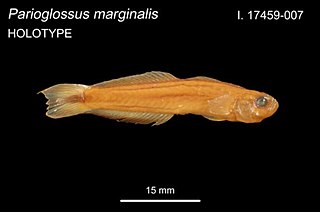 W
WParioglossus marginalis, also known as the blackmargin dartfish, is a species of dartfish native to the brackish waters of the coast of New South Wales, Australia and around the northern part of the North Island and Great Barrier Island in New Zealand, This species may be an introduced species in New Zealand, being brought from Australia in ship's ballast water. This species can reach a length of 3.3 centimetres (1.3 in) SL. It is thought by some workers that Parioglossus neoclaedonicus from New Caledonia may be a synonym of P. marginalis and that the Caroline Islands species Parioglossus verticalis, which is known form just a single specimen, may also be synonymous with this species. To resolve these taxonomic uncertainties molecular studies will be required.
 W
WThe Northern straight-mouth nase is a species of ray-finned fish in the family Cyprinidae. It is found in Portugal and Spain. Its natural habitat is rivers. It is threatened by habitat loss.
 W
WThe rainbow slender wrasse, also known as the painted rainbow wrasse, is a species of marine ray-finned fish, a wrasse from the family Labridae. It is native to the western Pacific Ocean where it is found from Japan to Australia and east to New Zealand. It occurs on reefs at depths from 13 to 100 m, usually over patches of sand. This species can reach 13.5 cm (5.3 in) in total length.
 W
WThe Ramu rainbowfish is a species of fish in the family Melanotaeniidae. It is endemic to Papua New Guinea where it occurs in tributary streams of the Gogol River near Madang, but it has also been recorded from the middle Ramu basin. This species was described by Gerald R. Allen in n1985 and the type locality is given as "tributary of Ramu River about 3 kilometers south of Walium Village".
 W
WThe slender whiting is a poorly known species of inshore marine fish of the smelt whiting family, Sillaginidae that has a distribution limited to the Persian Gulf only. The Slender whiting, like most sillaginids requires careful study to determine its identity, with ray and vertebrae counts as well as swim bladder morphology distinguishing features. This inshore species of fish is commonly taken by fishermen using beach seines and is sold fresh in local markets.
 W
WThe small-eyed whiting, Sillago microps, is a poorly known species of coastal marine fish of the smelt-whiting family Sillaginidae. The species is known from only two specimens; the holotype collected by Roland McKay in 1985 from a Taipei market, both specimens of which were taken from the waters of Taiwan. Apart from a relatively small eye size, the species is hard to distinguish from other common species of sillaginid taken in the area, and may be a minor part of local fisheries.
 W
WThe smoothtooth blacktip shark is a species of requiem shark in the family Carcharhinidae. It is known only from the type specimen caught from the Gulf of Aden, off eastern Yemen, and a handful of additional specimens caught from the Persian Gulf, off Kuwait. Reaching 1.3 m (4.3 ft) in length, this species has a stocky greenish-colored body, a short snout, and black-tipped fins. It can be distinguished from similar species by its teeth, which are narrow, erect, and smooth-edged.
 W
WStegastes nigricans, the dusky farmerfish, is a species of damselfish found around coral reefs at a depth of one to 12 meters, in tropical climates between 30°S and 30°N. They are known for farming monocultures of algae such as cyanophores and rhodophytes.
 W
WStegastes pelicieri, commonly known as the Mauritian gregory, is a damselfish of the family Pomacentridae. It is native to the islands of Mauritius and Réunion in the western Indian Ocean where it is found at depths between two and twenty metres. It lives on rocky reefs in areas with little coral but plenty of holes and crevices.
 W
WThe western school whiting, also known as the banded whiting, golden whiting and bastard whiting, is a species of benthic marine fish in the smelt-whiting family Sillaginidae. The species is one of three 'school whiting' that inhabit southern Australia and share a very similar appearance. Western school whiting are known to grow to 30 cm in length and 275 g in weight, although unconfirmed reports suggest this might be an underestimate. The western school whiting is distributed along the Western Australian coast from Maud Landing in the north to Rottnest Island in the south. The species inhabits both shallow inshore environments and waters to depths of 55 m. The species is a benthic predator, taking a variety of crustaceans, molluscs and echinoderms, and shows a change in diet with age and habitat. S. vittata is a multiple spawner, reproducing between December and February once it has reached one or two years of age. Juveniles inhabit protected inshore waters, moving offshore once they reach sexual maturity. It is often found in association with other sillaginids and comprises a minor fraction of commercial whiting catches in Western Australia.
 W
WThe whitetip weasel shark is a weasel shark of the family Hemigaleidae. Only one specimen, caught off Kosi Bay, South Africa, has been caught. That specimen was 96 cm long. In 2020, a fuzzy image believed to be this shark was obtained on the show Extinct or Alive.
 W
WThe yellow sand cichlid is a species of cichlid endemic to Lake Tanganyika where it is found in schools in areas with sandy substrates. This species can reach a length of 9.2 centimetres (3.6 in) TL. It can also be found in the aquarium trade.